Hospitality Simulation Management Assignment: Revenue and Cash Flow
VerifiedAdded on 2022/08/12
|9
|974
|17
Homework Assignment
AI Summary
This assignment solution addresses a Hospitality Simulation Management scenario, encompassing financial analysis, revenue management, and cash flow projections. Part A focuses on understanding cash flow statements and depreciation. Part B explores revenue management strategies, including pricing adjustments, service offerings, and occupancy rate optimization. Part C presents a cash budget and a statement of cash flows, analyzing the motel's financial performance and identifying factors impacting its cash balance, such as accounts receivable, inventory, and investment decisions. The solution highlights the importance of balancing profitability with cash management, offering insights into how operational efficiency and strategic financial planning contribute to a business's financial health.
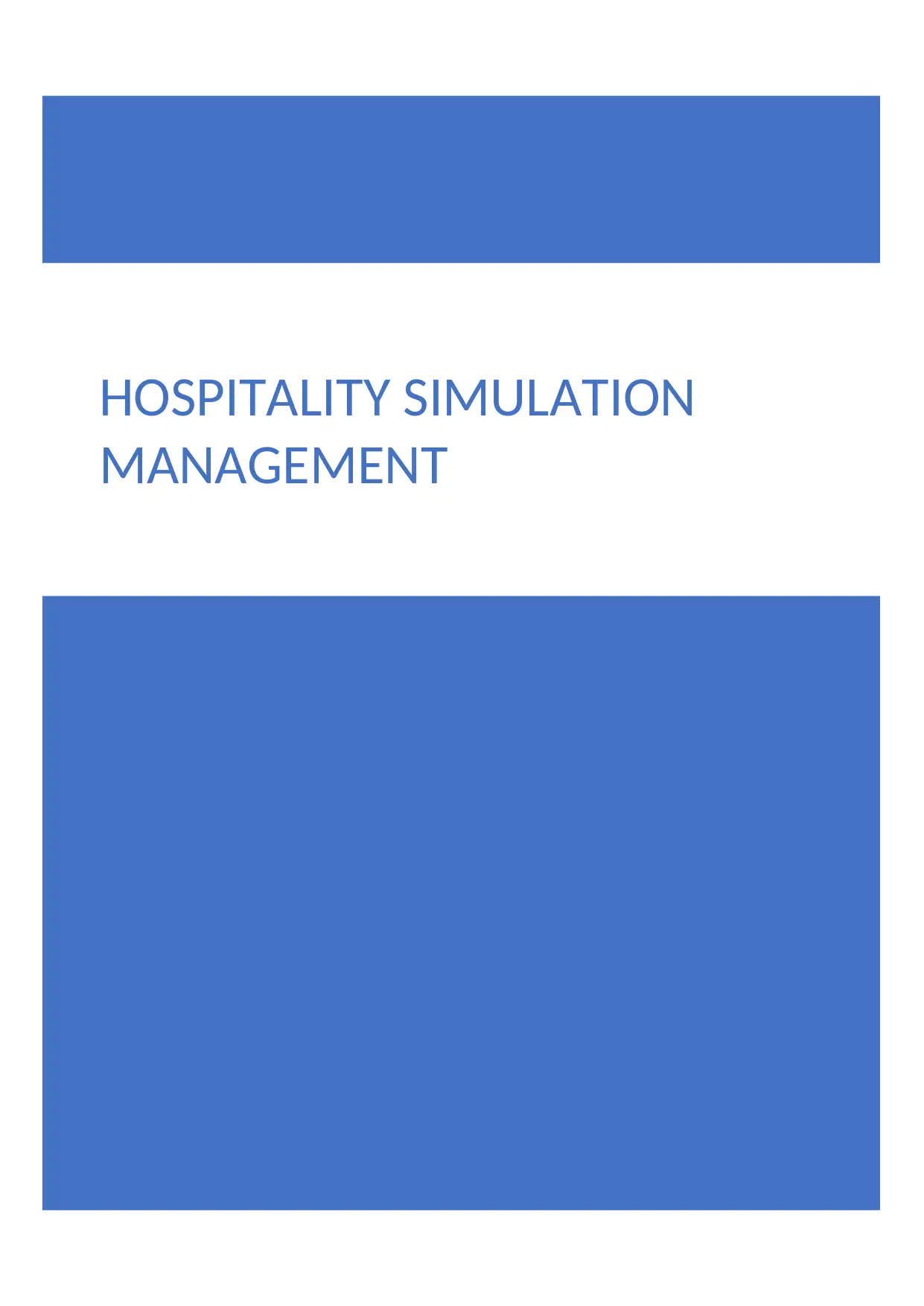
HOSPITALITY SIMULATION
MANAGEMENT
MANAGEMENT
Paraphrase This Document
Need a fresh take? Get an instant paraphrase of this document with our AI Paraphraser
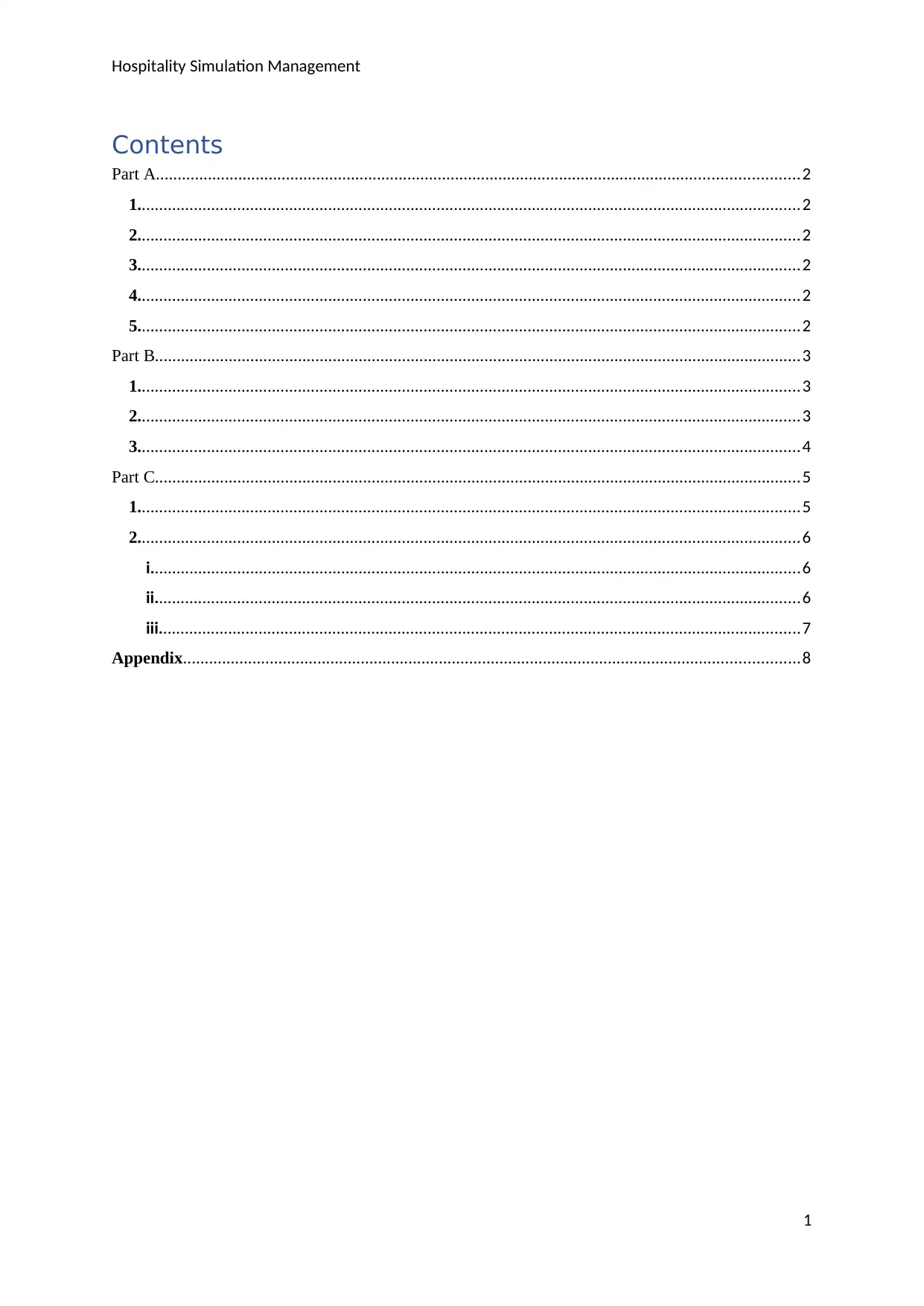
Hospitality Simulation Management
Contents
Part A....................................................................................................................................................2
1.........................................................................................................................................................2
2.........................................................................................................................................................2
3.........................................................................................................................................................2
4.........................................................................................................................................................2
5.........................................................................................................................................................2
Part B.....................................................................................................................................................3
1.........................................................................................................................................................3
2.........................................................................................................................................................3
3.........................................................................................................................................................4
Part C.....................................................................................................................................................5
1.........................................................................................................................................................5
2.........................................................................................................................................................6
i......................................................................................................................................................6
ii.....................................................................................................................................................6
iii....................................................................................................................................................7
Appendix..............................................................................................................................................8
1
Contents
Part A....................................................................................................................................................2
1.........................................................................................................................................................2
2.........................................................................................................................................................2
3.........................................................................................................................................................2
4.........................................................................................................................................................2
5.........................................................................................................................................................2
Part B.....................................................................................................................................................3
1.........................................................................................................................................................3
2.........................................................................................................................................................3
3.........................................................................................................................................................4
Part C.....................................................................................................................................................5
1.........................................................................................................................................................5
2.........................................................................................................................................................6
i......................................................................................................................................................6
ii.....................................................................................................................................................6
iii....................................................................................................................................................7
Appendix..............................................................................................................................................8
1
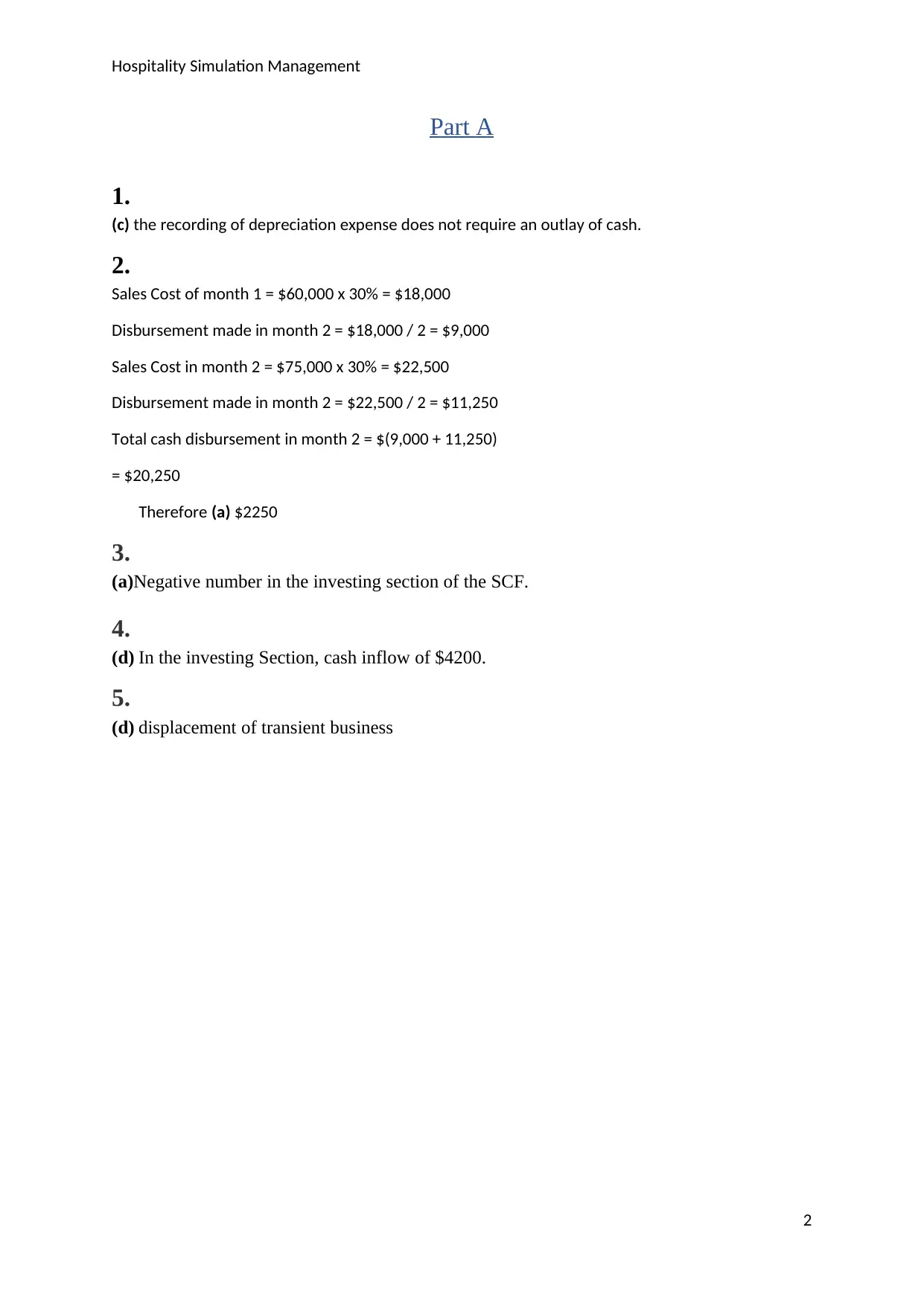
Hospitality Simulation Management
Part A
1.
(c) the recording of depreciation expense does not require an outlay of cash.
2.
Sales Cost of month 1 = $60,000 x 30% = $18,000
Disbursement made in month 2 = $18,000 / 2 = $9,000
Sales Cost in month 2 = $75,000 x 30% = $22,500
Disbursement made in month 2 = $22,500 / 2 = $11,250
Total cash disbursement in month 2 = $(9,000 + 11,250)
= $20,250
Therefore (a) $2250
3.
(a)Negative number in the investing section of the SCF.
4.
(d) In the investing Section, cash inflow of $4200.
5.
(d) displacement of transient business
2
Part A
1.
(c) the recording of depreciation expense does not require an outlay of cash.
2.
Sales Cost of month 1 = $60,000 x 30% = $18,000
Disbursement made in month 2 = $18,000 / 2 = $9,000
Sales Cost in month 2 = $75,000 x 30% = $22,500
Disbursement made in month 2 = $22,500 / 2 = $11,250
Total cash disbursement in month 2 = $(9,000 + 11,250)
= $20,250
Therefore (a) $2250
3.
(a)Negative number in the investing section of the SCF.
4.
(d) In the investing Section, cash inflow of $4200.
5.
(d) displacement of transient business
2
⊘ This is a preview!⊘
Do you want full access?
Subscribe today to unlock all pages.

Trusted by 1+ million students worldwide
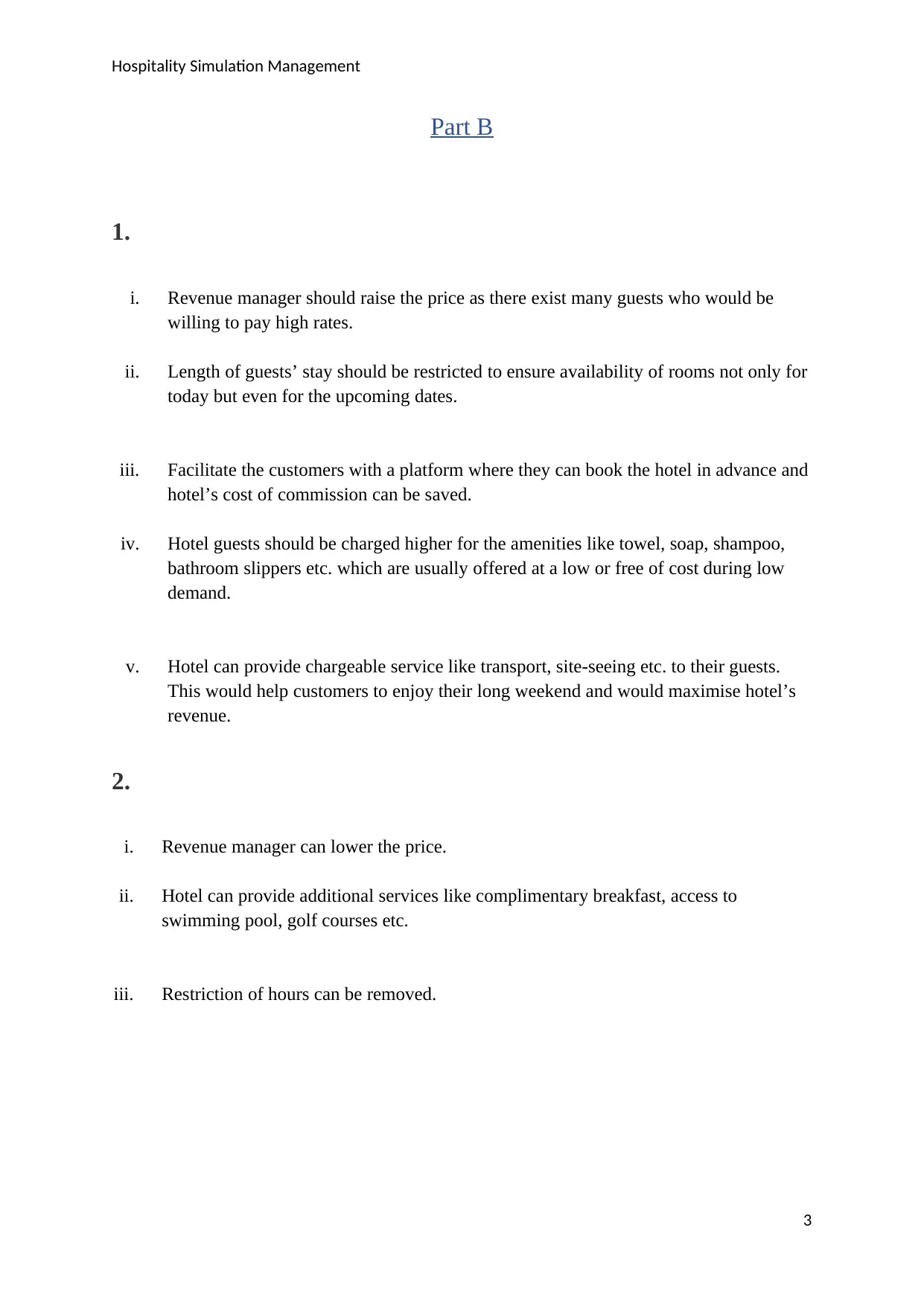
Hospitality Simulation Management
Part B
1.
i. Revenue manager should raise the price as there exist many guests who would be
willing to pay high rates.
ii. Length of guests’ stay should be restricted to ensure availability of rooms not only for
today but even for the upcoming dates.
iii. Facilitate the customers with a platform where they can book the hotel in advance and
hotel’s cost of commission can be saved.
iv. Hotel guests should be charged higher for the amenities like towel, soap, shampoo,
bathroom slippers etc. which are usually offered at a low or free of cost during low
demand.
v. Hotel can provide chargeable service like transport, site-seeing etc. to their guests.
This would help customers to enjoy their long weekend and would maximise hotel’s
revenue.
2.
i. Revenue manager can lower the price.
ii. Hotel can provide additional services like complimentary breakfast, access to
swimming pool, golf courses etc.
iii. Restriction of hours can be removed.
3
Part B
1.
i. Revenue manager should raise the price as there exist many guests who would be
willing to pay high rates.
ii. Length of guests’ stay should be restricted to ensure availability of rooms not only for
today but even for the upcoming dates.
iii. Facilitate the customers with a platform where they can book the hotel in advance and
hotel’s cost of commission can be saved.
iv. Hotel guests should be charged higher for the amenities like towel, soap, shampoo,
bathroom slippers etc. which are usually offered at a low or free of cost during low
demand.
v. Hotel can provide chargeable service like transport, site-seeing etc. to their guests.
This would help customers to enjoy their long weekend and would maximise hotel’s
revenue.
2.
i. Revenue manager can lower the price.
ii. Hotel can provide additional services like complimentary breakfast, access to
swimming pool, golf courses etc.
iii. Restriction of hours can be removed.
3
Paraphrase This Document
Need a fresh take? Get an instant paraphrase of this document with our AI Paraphraser
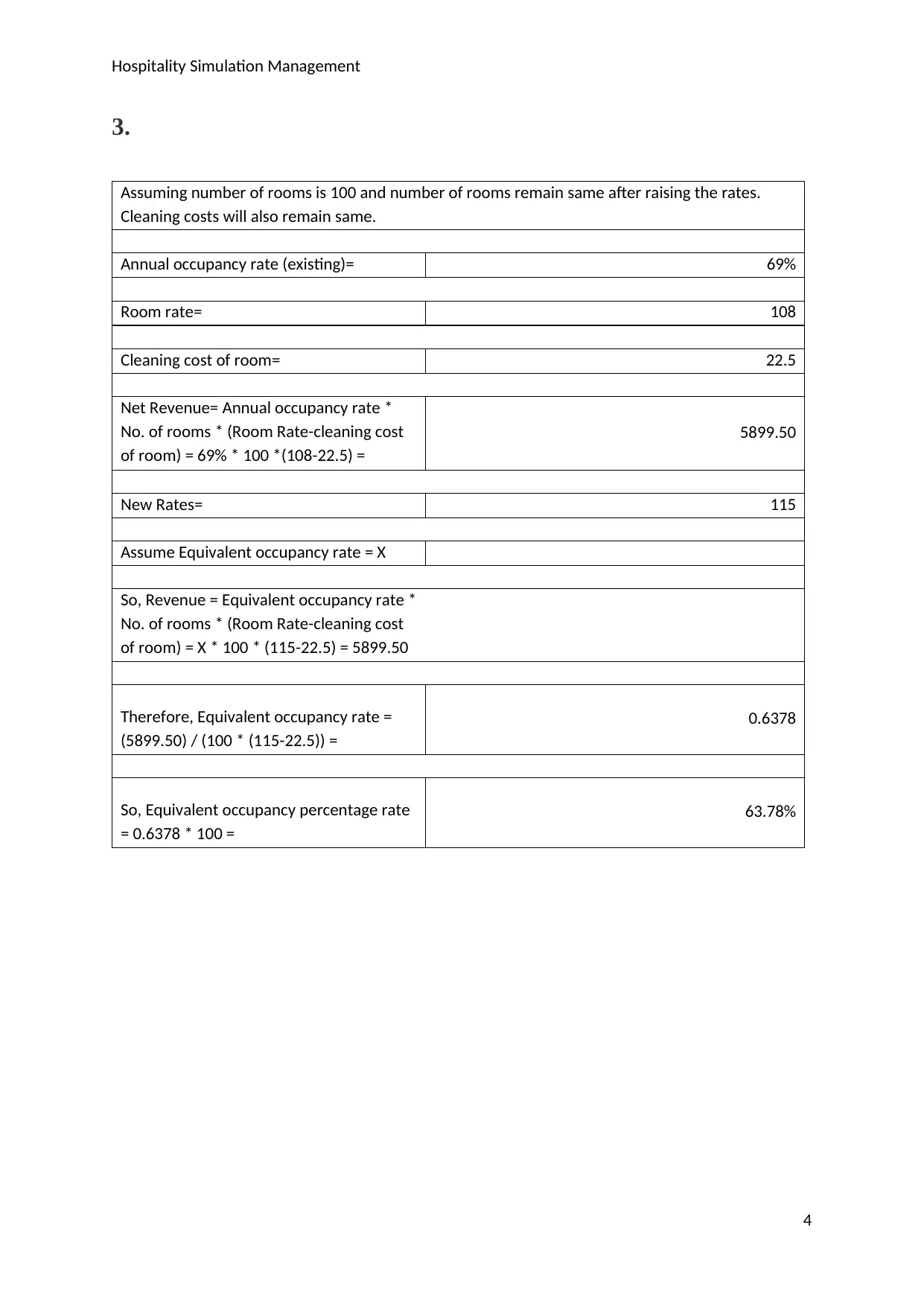
Hospitality Simulation Management
3.
Assuming number of rooms is 100 and number of rooms remain same after raising the rates.
Cleaning costs will also remain same.
Annual occupancy rate (existing)= 69%
Room rate= 108
Cleaning cost of room= 22.5
Net Revenue= Annual occupancy rate *
No. of rooms * (Room Rate-cleaning cost
of room) = 69% * 100 *(108-22.5) =
5899.50
New Rates= 115
Assume Equivalent occupancy rate = X
So, Revenue = Equivalent occupancy rate *
No. of rooms * (Room Rate-cleaning cost
of room) = X * 100 * (115-22.5) = 5899.50
Therefore, Equivalent occupancy rate =
(5899.50) / (100 * (115-22.5)) =
0.6378
So, Equivalent occupancy percentage rate
= 0.6378 * 100 =
63.78%
4
3.
Assuming number of rooms is 100 and number of rooms remain same after raising the rates.
Cleaning costs will also remain same.
Annual occupancy rate (existing)= 69%
Room rate= 108
Cleaning cost of room= 22.5
Net Revenue= Annual occupancy rate *
No. of rooms * (Room Rate-cleaning cost
of room) = 69% * 100 *(108-22.5) =
5899.50
New Rates= 115
Assume Equivalent occupancy rate = X
So, Revenue = Equivalent occupancy rate *
No. of rooms * (Room Rate-cleaning cost
of room) = X * 100 * (115-22.5) = 5899.50
Therefore, Equivalent occupancy rate =
(5899.50) / (100 * (115-22.5)) =
0.6378
So, Equivalent occupancy percentage rate
= 0.6378 * 100 =
63.78%
4
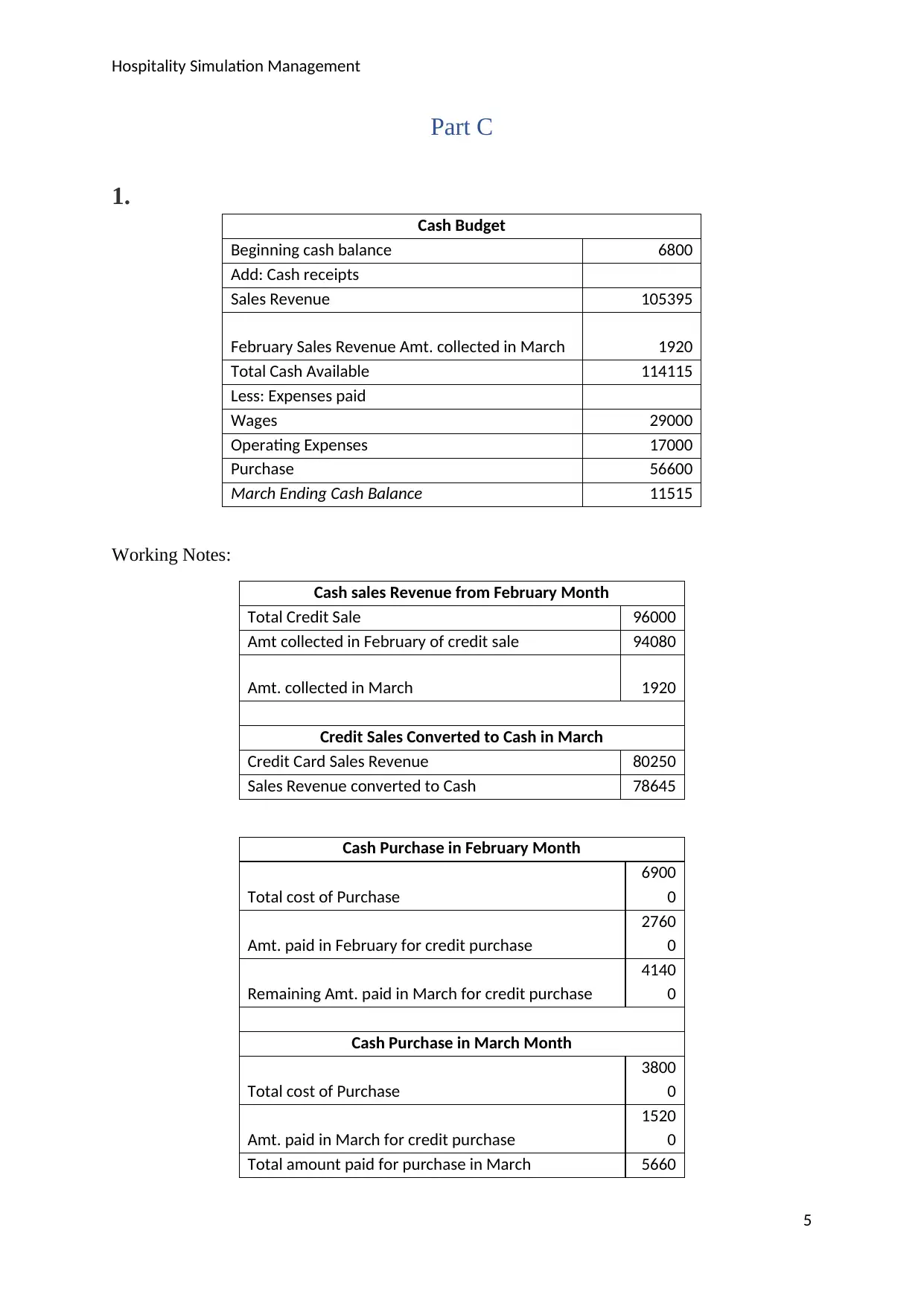
Hospitality Simulation Management
Part C
1.
Cash Budget
Beginning cash balance 6800
Add: Cash receipts
Sales Revenue 105395
February Sales Revenue Amt. collected in March 1920
Total Cash Available 114115
Less: Expenses paid
Wages 29000
Operating Expenses 17000
Purchase 56600
March Ending Cash Balance 11515
Working Notes:
Cash sales Revenue from February Month
Total Credit Sale 96000
Amt collected in February of credit sale 94080
Amt. collected in March 1920
Credit Sales Converted to Cash in March
Credit Card Sales Revenue 80250
Sales Revenue converted to Cash 78645
Cash Purchase in February Month
Total cost of Purchase
6900
0
Amt. paid in February for credit purchase
2760
0
Remaining Amt. paid in March for credit purchase
4140
0
Cash Purchase in March Month
Total cost of Purchase
3800
0
Amt. paid in March for credit purchase
1520
0
Total amount paid for purchase in March 5660
5
Part C
1.
Cash Budget
Beginning cash balance 6800
Add: Cash receipts
Sales Revenue 105395
February Sales Revenue Amt. collected in March 1920
Total Cash Available 114115
Less: Expenses paid
Wages 29000
Operating Expenses 17000
Purchase 56600
March Ending Cash Balance 11515
Working Notes:
Cash sales Revenue from February Month
Total Credit Sale 96000
Amt collected in February of credit sale 94080
Amt. collected in March 1920
Credit Sales Converted to Cash in March
Credit Card Sales Revenue 80250
Sales Revenue converted to Cash 78645
Cash Purchase in February Month
Total cost of Purchase
6900
0
Amt. paid in February for credit purchase
2760
0
Remaining Amt. paid in March for credit purchase
4140
0
Cash Purchase in March Month
Total cost of Purchase
3800
0
Amt. paid in March for credit purchase
1520
0
Total amount paid for purchase in March 5660
5
⊘ This is a preview!⊘
Do you want full access?
Subscribe today to unlock all pages.

Trusted by 1+ million students worldwide
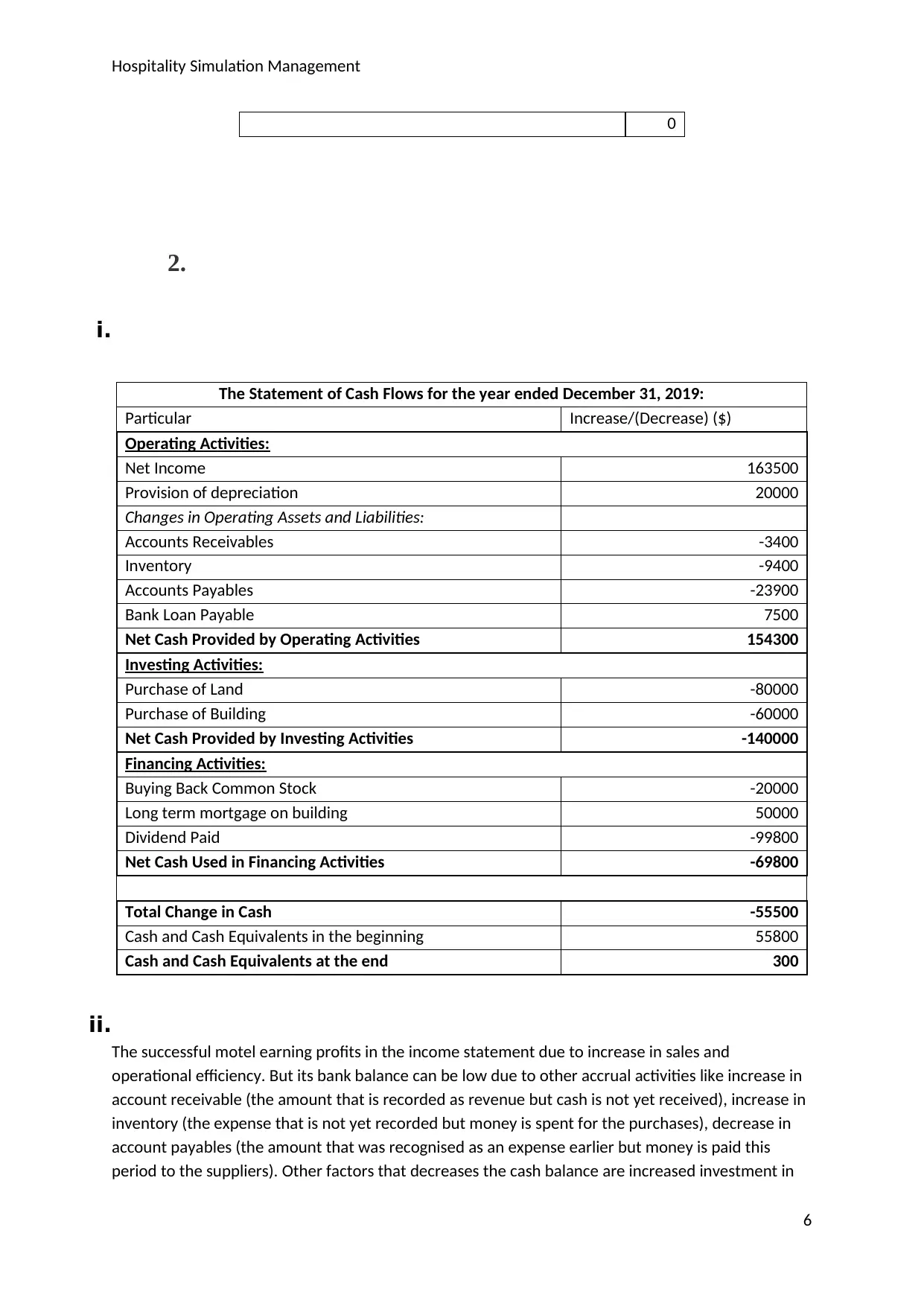
Hospitality Simulation Management
0
2.
i.
The Statement of Cash Flows for the year ended December 31, 2019:
Particular Increase/(Decrease) ($)
Operating Activities:
Net Income 163500
Provision of depreciation 20000
Changes in Operating Assets and Liabilities:
Accounts Receivables -3400
Inventory -9400
Accounts Payables -23900
Bank Loan Payable 7500
Net Cash Provided by Operating Activities 154300
Investing Activities:
Purchase of Land -80000
Purchase of Building -60000
Net Cash Provided by Investing Activities -140000
Financing Activities:
Buying Back Common Stock -20000
Long term mortgage on building 50000
Dividend Paid -99800
Net Cash Used in Financing Activities -69800
Total Change in Cash -55500
Cash and Cash Equivalents in the beginning 55800
Cash and Cash Equivalents at the end 300
ii.
The successful motel earning profits in the income statement due to increase in sales and
operational efficiency. But its bank balance can be low due to other accrual activities like increase in
account receivable (the amount that is recorded as revenue but cash is not yet received), increase in
inventory (the expense that is not yet recorded but money is spent for the purchases), decrease in
account payables (the amount that was recognised as an expense earlier but money is paid this
period to the suppliers). Other factors that decreases the cash balance are increased investment in
6
0
2.
i.
The Statement of Cash Flows for the year ended December 31, 2019:
Particular Increase/(Decrease) ($)
Operating Activities:
Net Income 163500
Provision of depreciation 20000
Changes in Operating Assets and Liabilities:
Accounts Receivables -3400
Inventory -9400
Accounts Payables -23900
Bank Loan Payable 7500
Net Cash Provided by Operating Activities 154300
Investing Activities:
Purchase of Land -80000
Purchase of Building -60000
Net Cash Provided by Investing Activities -140000
Financing Activities:
Buying Back Common Stock -20000
Long term mortgage on building 50000
Dividend Paid -99800
Net Cash Used in Financing Activities -69800
Total Change in Cash -55500
Cash and Cash Equivalents in the beginning 55800
Cash and Cash Equivalents at the end 300
ii.
The successful motel earning profits in the income statement due to increase in sales and
operational efficiency. But its bank balance can be low due to other accrual activities like increase in
account receivable (the amount that is recorded as revenue but cash is not yet received), increase in
inventory (the expense that is not yet recorded but money is spent for the purchases), decrease in
account payables (the amount that was recognised as an expense earlier but money is paid this
period to the suppliers). Other factors that decreases the cash balance are increased investment in
6
Paraphrase This Document
Need a fresh take? Get an instant paraphrase of this document with our AI Paraphraser
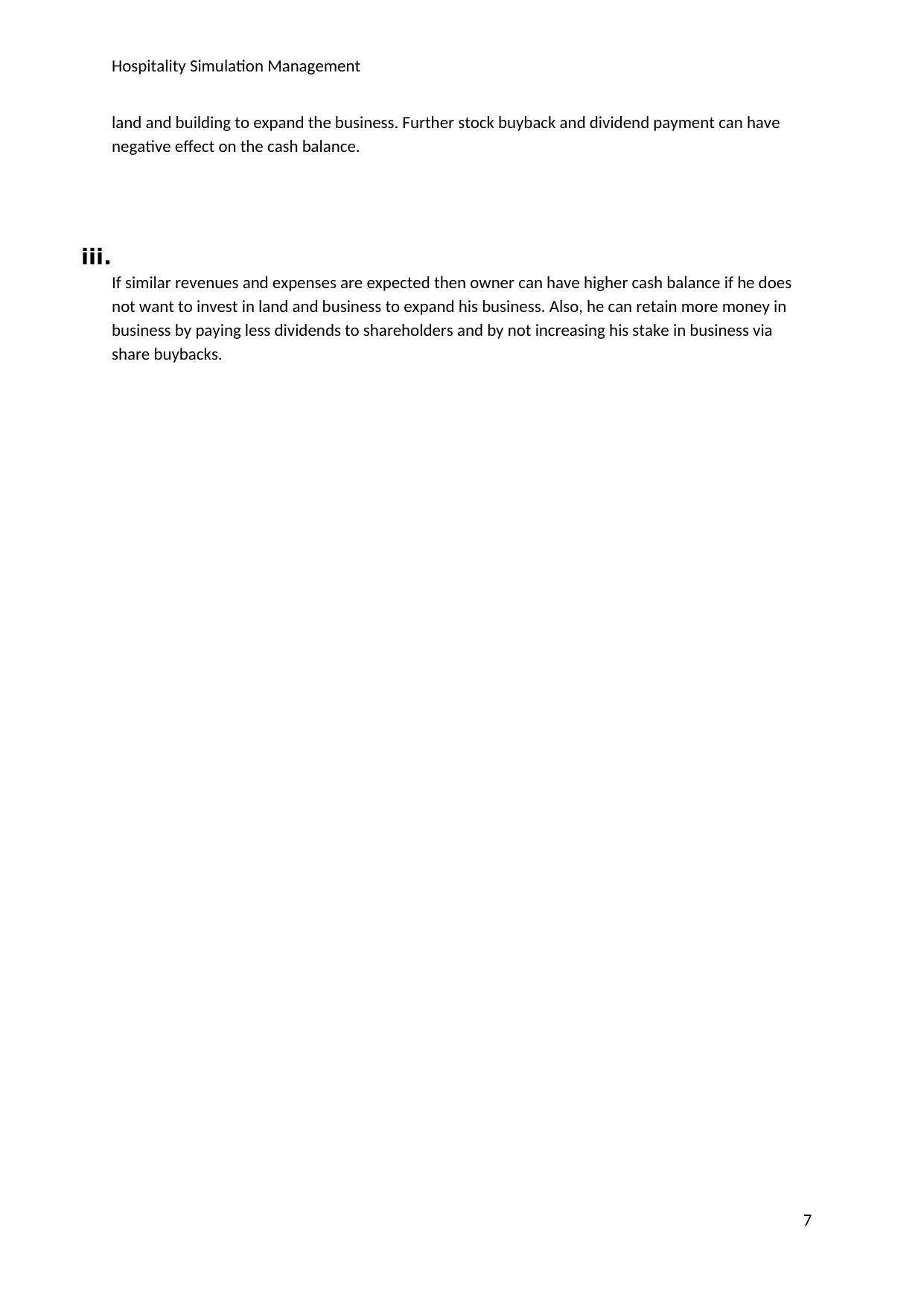
Hospitality Simulation Management
land and building to expand the business. Further stock buyback and dividend payment can have
negative effect on the cash balance.
iii.
If similar revenues and expenses are expected then owner can have higher cash balance if he does
not want to invest in land and business to expand his business. Also, he can retain more money in
business by paying less dividends to shareholders and by not increasing his stake in business via
share buybacks.
7
land and building to expand the business. Further stock buyback and dividend payment can have
negative effect on the cash balance.
iii.
If similar revenues and expenses are expected then owner can have higher cash balance if he does
not want to invest in land and business to expand his business. Also, he can retain more money in
business by paying less dividends to shareholders and by not increasing his stake in business via
share buybacks.
7
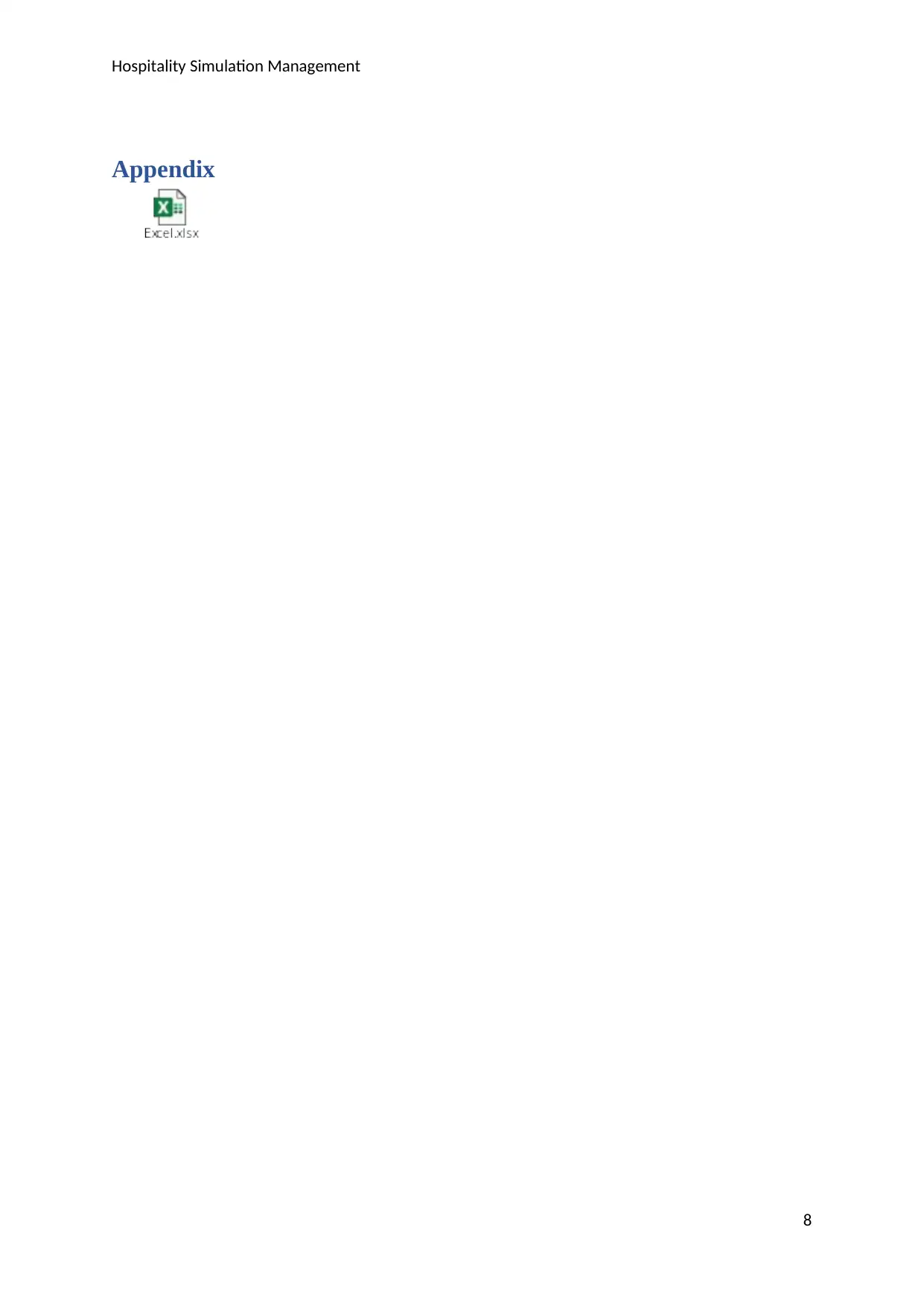
Hospitality Simulation Management
Appendix
8
Appendix
8
⊘ This is a preview!⊘
Do you want full access?
Subscribe today to unlock all pages.

Trusted by 1+ million students worldwide
1 out of 9
Your All-in-One AI-Powered Toolkit for Academic Success.
+13062052269
info@desklib.com
Available 24*7 on WhatsApp / Email
![[object Object]](/_next/static/media/star-bottom.7253800d.svg)
Unlock your academic potential
Copyright © 2020–2025 A2Z Services. All Rights Reserved. Developed and managed by ZUCOL.

